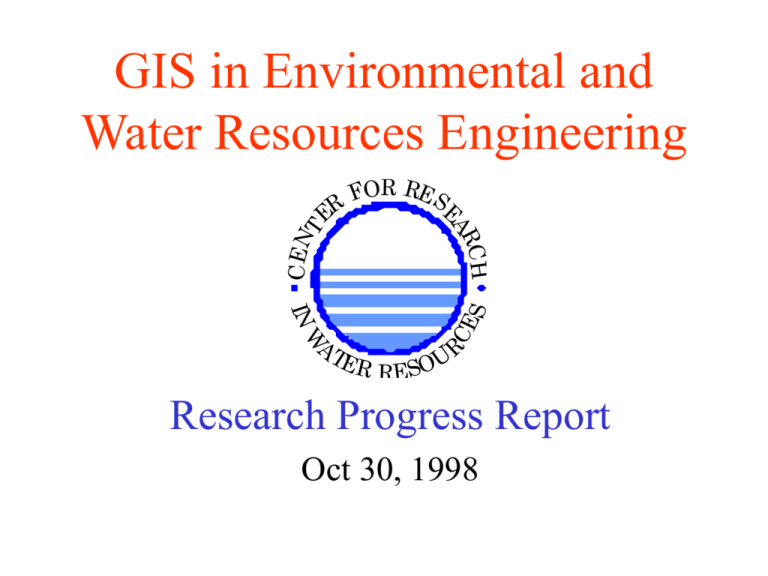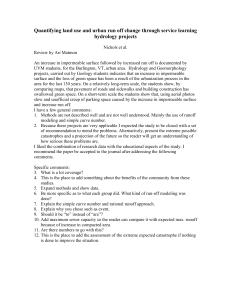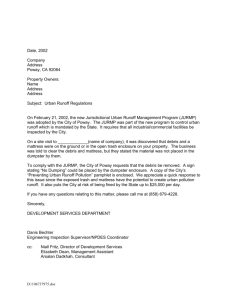Seth Ahrens - The University of Texas at Austin
advertisement

FOR RE S E ER CE S W IN AT ER CH AR CEN T GIS in Environmental and Water Resources Engineering R U RESO Research Progress Report Oct 30, 1998 Research Areas • Texas data and water modeling: Hudgens, Mason, Davis Jonsdottir, Gu, Niazi • Environmental Risk Assessment: HayWilson, Romanek, Kim • Global runoff: Asante, Lear • Nonpoint source pollution: Melancon, Osborne • Flood hydrology and hydraulics: Ahrens, Bigelow, Perales, Tate • Internet: Wei Research Areas • Texas data and water modeling: Hudgens, Mason, Davis Jonsdottir, Gu, Niazi • Environmental Risk Assessment: HayWilson, Romanek, Kim • Global runoff: Asante, Lear • Nonpoint source pollution: Melancon, Osborne • Flood hydrology and hydraulics: Ahrens, Bigelow, Perales, Tate • Internet: Wei Brad Hudgens Geospatial Data Development for Water Availability Modeling GIS & WAM Digital Raster Graphic Basemap Network Checking David Mason Geospatial Data Development for Water Availability Modeling Stream Network Construction Download and Project rf3 File: Edit rf3 to Obtain “Clean” Network: Create Outlet Points Using the basin water right coverage as a guide, outlet points were created along the stream network in order to form control points for the eventual watershed delineation: Trinity River TMDL Subtask on Network Analyst Kim Davis For Starters... This is the Guadalupe River Basin, after using CRWR-Prepro on it and vectorizing the stream links. It was a good test case because... • Density--I wanted a small data set to learn with • NO GAPS--Network Analyst doesn’t handle gaps or lakes well. • Availability--I had already done the Prepro work for class... Add some Points of Interest These are evaporation stations from a coverage of Texas. In a real analysis, these might be water rights, point sources, stream gages, etc... Use Network Analyst This shows the results of route planning from a point to the outlet. Cool Stuff • • • • • • Network analyst can be made to look only downstream Network analyst can be made to look only upstream Network analyst can look both ways It can show you hydrologic connectivity It doesn’t require that input data be digitized It handles points not EXACTLY on the network Caveats • Network is very sensitive to digitizing errors • Won’t show you WHERE connectivity is broken • Files must be prepared properly (From Nodes and To Nodes) • Aimed at transportation, not rivers Jona Finndis Jonsdottir Geospatial Data for Total Maximum Daily Loads Trinity Basin RF3 River Network Original RF3 file Rf3 file, where lakes and double lines have been taken out Original Rf3 file Simplified version of Rf3, with centerlines Richard Gu GIS Connections for Hydrologic Modeling GIS Application to TxRR Ungaged Inflow and Instream Habitat Modeling CRWR, the University of Texas at Austin Texas Water Development Board TxRR Model Initial Abstraction Precipitation P Direct runoff QD Soil Retention S Maximum Soil Moisture SMMAX Stream Flow Base Flow QB Soil Moisture SM Percolation Tasks • Preprocessing Tools for TxRR • TxRR Model Execution • Postprocessing Tools for TxRR Software Environment for TxRR Model Execution Source Data Database Input Data GIS Output data TxRR Program Database • Database construction is the essential part of the project. • All the data will be stored and used efficiently. • Data linking: – GIS, Database, and TxRR model are constructed independently – Data required for each procedure are retrieved from Database on demand – Output data are written back to database . • Software: Microsoft Access. Arcview GIS • Preprocessing tools. • Output results display. Programming Languages • Fortran: TxRR Model Calculation. • Visual Basic: database interfaces. • Avenue: GIS tools developing and function invoking. Implementation Issues • Speed: Avenue or Basic • Data interactions between programs • Software integration Surface/Subsurface Modeling Progress Report by: Shiva Niazi Ann Dennis October 30, 1998 Overview • Background work conducted by HDR Engineering and LBG Guyton Assoc. • Carrizo- Wilcox Aquifer Model Domain • Conceptualizing the Subsurface/Surface Model • Future Work Difficulties in modeling the MODFLOW data • MODFLOW model domain is not in “real” map coordinates • Size of grid cells vary • Direction of rows and columns are not standardized to North/South and East/West Model Domain Future Work • Locate the MODFLOW model domain on a map • Extract model domain by using county, river reach, HUC and aquifer maps • Investigate the capabilities of Argus One and GMS to manipulate MODFLOW data files Research Areas • Texas data and water modeling: Hudgens, Mason, Davis Jonsdottir, Gu, Niazi • Environmental Risk Assessment: HayWilson, Romanek, Kim • Global runoff: Asante, Lear • Nonpoint source pollution: Melancon, Osborne • Flood hydrology and hydraulics: Ahrens, Bigelow, Perales, Tate • Internet: Wei Lesley Hay Wilson Spatial Environmental Risk Assessment Current Research Status • Drafting dissertation proposal • Objective is to develop the spatial risk assessment methodology – Spatial Risk Assessment (SRA) is the process of identifying and quantifying the potential for adverse effects to human or ecological receptors from chemicals or radioactive materials released to the natural environment within a spatially-referenced, integrated modeling environment Necessary Elements of the SRA Methodology • Spatial Site Conceptual Model • Connections to implement map-based modeling of fate & transport • Meta data protocols for environmental measurements and derived results • Managing time-dependent data sets • Visualization of uncertainty • Communication tools Other Activities • Completed workshop for PaDEP and EPA on the first CD (team) • Presented two papers at the ASCE Geo Institute meeting, co-authored third paper • Working on poster for ESP meeting next week (team) • Completing paper for the 1999 CSIRO Remediation Conference (team) Andrew Romanek Surface Representation of the Marcus Hook Refinery Current Activities • Team Efforts: – PADEP Workshop on ArcView and Access – ESP Poster • 1st year progress CD • Groundwater Model with GMS • Seminar next Wednesday Groundwater Results • • • • Lube Plant Area Steady State 3 layer simplification Where from here??? Spatial Analysis of Sources and Source Areas on Marcus Hook Progress report by Julie Kim Friday, October 30, 1998 Objective • To find a correlation between where chemicals were stored and where they were detected within the Lube Plant Getting Started: Data Acquired • Sept. 11, 1998 Former Marcus Hook Refinery progress documentation CD-Rom • Tosco’s Environmental baseline assessment of areas of concern (AOC) • Summary of chemicals of concern (COC) issues compiled on Sept. 28, 1998 • Appendix of data quality classification system Current Work • Compile map of coverages using CD-Rom: tank, old RCRA units, and historical • Identify each unit or AOC and look up basis of concern in Tosco database • Determine materials and volumes stored, time period of operation, and releases • Determine quality of data Future Work • Develop contour maps of COC with associated data quality levels • Determine correlation for the entire facility Research Areas • Texas data and water modeling: Hudgens, Mason, Davis Jonsdottir, Gu, Niazi • Environmental Risk Assessment: HayWilson, Romanek, Kim • Global runoff: Asante, Lear • Nonpoint source pollution: Melancon, Osborne • Flood hydrology and hydraulics: Ahrens, Bigelow, Perales, Tate • Internet: Wei Kwabena Asante Continental Scale Runoff Routing Routing GCM Runoff • • • • • Global Daily Precipitation Simulated Simulation on 128x64 (2.8o) mesh Runoff generated by soil water balance Runoff Routed to Continental margin 10 years of daily runoff routed Major Basins of North America Major Basins of Africa Mary Lear Grid Cell Translation from High to Low Resolution Project Description • Create an algorithm in Arc Macro Language (AML) • Apply the algorithm to a sample area Niger River Basin • Examine the accuracy of output • Apply the algorithm globally Learning in Progress • Understanding existing resampling AML programs • Converting from grid to polygon coverage? • Having fun learning AML Low resolution mesh on Fine Grid Research Areas • Texas data and water modeling: Hudgens, Mason, Davis Jonsdottir, Gu, Niazi • Environmental Risk Assessment: HayWilson, Romanek, Kim • Global runoff: Asante, Lear • Nonpoint source pollution: Melancon, Osborne • Flood hydrology and hydraulics: Ahrens, Bigelow, Perales, Tate • Internet: Wei Patrice Melancon Pollutant Loading Model for Tillamook Bay Update on Patrice’s Work • Have written about 25 pages; mostly database development and hydrology part. • Assumptions made about BMP effectiveness and current level of implementation (based on 1991 Rural Clean Water Progress Report). • Using Summarize by Zones, backed out to EMC for CAFO land use to match E&S averages for 5 basins - see next slides for data • Calculated bay volumes and detention times for low, average, and high tides - see last slide for data. • Doing literature search to support EMC values. • Outline of report being written to help focus writing effort. BMP Effects - CAFOs Resultant Septic Runoff System conc MS/MH MS/MH PMA PMA % RB % RB % % % Failure Rate Model RO Model BF Landuse Type (fc/100ml) % Red % Imp % Red Imp Red Imp Effective Remain (%) Conc Conc 11 Urban 2000 2000 100 12 Urban 2000 2000 100 13 Urban 2000 2000 100 14 Urban 2000 2000 100 16 Urban 2000 2000 100 17 Urban 2000 2000 100 18 Rur Res 8000 0.07 0.07 560 100 19 Rur Ind 10000 10000 100 21 AgLand 1500 1500 100 23 CAFO 38905 0.4 0.54 0.6 0.56 0.25 0.05 0.49 0.51 20000 1000 24 AgLand 1500 1500 100 31 Range 20 20 5 42 Forest 20 20 5 43 Forest 20 20 5 51 Water 0 0 0 53 Water 0 0 0 62 Wetlands 0 0 0 74 Barren 20 20 5 75 Barren 20 20 5 Miami River Data - Analysis using Summarize by Zones Landuse 11 18 21 23 24 42 43 51 62 Land Type Urban Rur Res AgLand CAFO AgLand Forest Forest Water Wetlands Total Miami Runoff (cf/yr) Miami Baseflow (cf/yr) Runoff conc Baseflow Conc 6,373,520 14,798,682 2000 100 3,710,585 9,117,052 560 100 11,567,971 28,957,584 1500 100 31,036,984 77,448,448 20000 1000 242,047 585,000 1500 100 2,137,857,664 4,674,283,520 20 5 198,224,096 458,412,832 20 5 14,410,322 0 0 0 446,856 1,080,000 0 0 2,403,870,045 5,264,683,118 Total Run + Bflow Q*C 14226908200 2989632800 20247714900 6.98188E+11 421570500 66128570880 6256546080 0 0 8.08459E+11 7,668,553,163 Pred Conc (fc/100ml) Number to match is 133 fc/100 ml • • Runoff Conc values linked to spreadsheet on previous slide. Model runoff conc for CAFOs changed to get reasonable results for predicted concentration for each of 5 watersheds. Kilchis, Tillamook, and Trask are somewhat overestimated. Wilson is somewhat underestimated. 105 Tide Volumes and Detention Times Segment Name Main Bay Main Bay Cape Meares Flower Pot Upper Bay Growing Management Prohibited Conditionally Approved Conditionally Approved Restricted Prohibited Area (sq ft) 38,513,980 106,330,392 74,312,616 21,975,494 101,338,632 Perimeter (ft) 50,591 42,280 38,397 29,768 59,668 Segment Main Bay - Prohibited Main Bay - Conditional Cape Meares Flower Pot Upper Bay Entire Bay Low Tide Volume (million cf) 497.59 408.37 111.5 19.9 66.23 1103.59 Mean Tide Volume (million cf) 630.42 796.97 344.36 95.36 334.96 2202.07 Hi Tide Volume (million cf) 781.61 1219.11 638.74 182.39 737.78 3559.63 Acc Runoff (cf/yr) Acc Baseflow (cf/yr) 2,969,500,928 6,014,152,192 789,442,688 224,035,568 644,523,072 332,789,056 201,451,328 131,975,008 31,885,703,168 69,625,946,112 36,490,621,184 76,328,897,936 td for Low Tide (days) 1.61 1.44 0.40 0.07 0.24 4 td for Mean Tide (days) 2.04 2.80 1.22 0.34 1.20 7 td for High Tide (days) 2.53 4.29 2.27 0.65 2.65 12 Katherine Osborne Water Quality Master Planning for Austin Watersheds delineated using 3” DEMs outline of watersheds from the City of Austin 7.5’ DEM sheet labels 7.5’ DEMs imported using ArcView Next Steps • • • • • • • Import DEMs using ArcInfo Add USGS Gauge points Obtain stream file from City of Austin Delineate watersheds Submit these watersheds to COA Read Urban Model material Attend GIS class in CRP Research Areas • Texas data and water modeling: Hudgens, Mason, Davis Jonsdottir, Gu, Niazi • Environmental Risk Assessment: HayWilson, Romanek, Kim • Global runoff: Asante, Lear • Nonpoint source pollution: Melancon, Osborne • Flood hydrology and hydraulics: Ahrens, Bigelow, Perales, Tate • Internet: Wei Seth Ahrens Flood Forecasting in Houston Final Version of Model Comparison of Gauge Areas (km2) Some DLG 792 No DLG 798 Actual Total All DLG 811 Katy 155 162 196 164 Bear 48 42 90 56 Langham 91 93 58 64 821 Moving GridParm into an ArcView Environment Goals by Next Meeting • Finish GridParm conversion. • Finish preparing all supporting data sets for the final report • Have most if not all of report finished. Ben Bigelow Midwest Flood Frequency Analysis Research Update • Writing Methodology Chapter for Report • Arranged travel to St. Louis for USACE meeting – HEC interested in research group’s DEM display ideas/capabilities – any POWERPOINT presentations? • Waiting on Rating curves for water surface profile Design Discharge Profile, Mississippi River Iowa-Cedar Rock Contribution of Des Moines River Alone: 128,000 cfs Tributary: 49,000 cfs Des Moines 1-day, 100-yr peak flow 450000 400000 Des Moines Mean Daily Discharge (cfs) 350000 300000 250000 200000 150000 0 50 100 150 200 250 300 350 Distance (miles) University of Texas at Austin Jerry Perales Soil Moisture Modeling in HECHMS Objective The objective of my research is to use spatial data to develop soil moisture accounting schemes for the Tenkiller Watershed using ArcView and a prototype model in Visual Basic called the Soil Water Balance Modeling System (SWBMS) developed by Sean Reed. Required Data Existing STATSGO and SSURGO soil databases for the Tenkiller Watershed A Nexrad cell mesh for the Tenkiller Watershed Analysis ArcView will be used to preprocess soil and land cover data with scripts created by Sean Reed. This preprocessed data will then be used as input data for SWBMS. The results of the water balance will then be compared to results which are produced by HECHMS. This comparison will help determine what modifications to the model are needed, if any. Eric Tate Mapping Flood Water Surface Elevation Terrain Modeling • Map cross-sections • Create cross-section bounding polygon • Convert DEM to points • Intersect DEM points with bounding polygon • Delete selected points • Form a TIN: cross-section points control the channel and floodplain, DEM points control elsewhere • Problems: ragged zone of transition, bridges/culverts Waller Creek at Town Lake Research Areas • Texas data and water modeling: Hudgens, Mason, Davis Jonsdottir, Gu, Niazi • Environmental Risk Assessment: HayWilson, Romanek, Kim • Global runoff: Asante, Lear • Nonpoint source pollution: Melancon, Osborne • Flood hydrology and hydraulics: Ahrens, Bigelow, Perales, Tate • Internet: Wei Kevin Wei Displaying Environmental Maps on the Internet Pantex Benzene monitoring data served by MO ArcExplore. Kevin.wei Query Builder Download Here, you access data from the Web. Or you can open ArcExplore, a free download software, to do the some job. I suggest don’t use Identify tool to query red one, because there are many data on the same location. Using Query builder is more efficient. if you like, you can query blue one which only contains geographic information to know which well is in where. Query Builder 1. Want to know the Benzene monitoring result of well “OW-WR-19”. 2. Condition 1 and concentration higher than 0.005 and need all information. 3. Handle the query result. Two ways: (1) save as text file (2) directly drag into Word or Excel. Data Statistics Data Download Specified when serving data You get a new shape file. If you are only interested in part of area, you can zoom in to there and download part of database. Research Review Next Research Progress Report Friday Nov13, 1998, 2PM, ECJ 9.236







